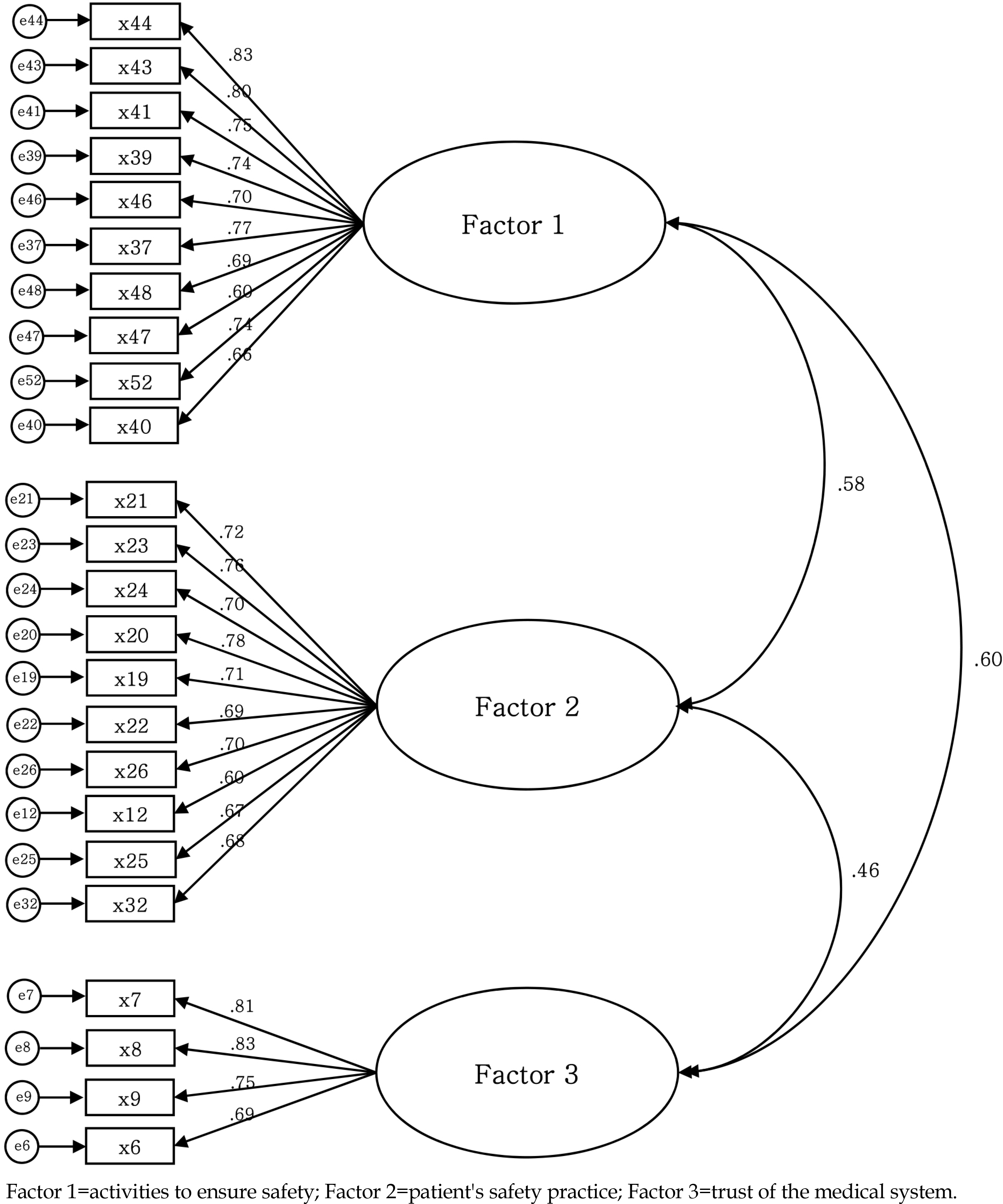Abstract
Purpose
The purpose of this study was to develop a instrument to evaluate patient safety perception in hospitalized patient and to examine its validity and reliability.
Methods
For the development of the initial items, the literature was reviewed along with the existing measuring tools. The items were evaluated by experts for content validity. This study was conducted from September 2017 to January 2018. A total of 294 hospitalized patients participated in the study to verify the validity and reliability of the instrument. Data were analyzed by item analysis, exploratory factor analysis, confirmatory factor analysis, criterion-related validity, and internal consistency.
Results
The final instrument were derived containing 24 items and 3 factors. There were 10 items on “ activities to ensure”, 10 items on “ patient's safety practices”, and 4 items on “ trust of the medical system.” The criterion-related validity was estab-lished using the Patient Measure of Safety (r=.72, p<.001). The Cronbach's ⍺ for this instrument was .93.
Go to : 
REFERENCES
1. Lee SG. Development and psychometric evaluation of the Korean patient safety culture survey instrument for hospitals [dissertation]. Seoul: Chung-Ang University;2015.
2. Lee SI. Necessity and enactment of patient safety law. Healthcare Policy Forum. 2013; 11(2):37–42.
3. de Vries EN, Ramrattan MA, Smorenburg SM, Gouma DJ, Boermeester MA. The incidence and nature of in-hospital adverse events: a systematic review. BMJ Quality & Safety. 2008; 17(3):216–23. https://doi.org/10.1136/qshc.2007.023622.

4. Waeschle RM, Bauer M, Schmidt CE. Errors in medicine: caus-es, impact and improvement measures to improve patient safety. Der Anaesthesist. 2015; 64(9):689–704. https://doi.org/10.1007/s00101-015-0052-4.
5. Wachter RM. Understanding patient safety. 2nd ed.New York: McGraw Hill Medical;2012.
6. World Health Organization. Patient safety [Internet]. Geneva: WHO;2009. [cited 2018 January 29]. Available from:. http://www.who.int/patientsafety/about/en/.
7. Baek SW, Lee SJ, Huh JE. Patient safety and accountability, improving medical ethics and patient safety. Seoul: Bomungak;2009.
8. Kim MR. Concept analysis of patient safety. Journal of Korean Academy of Nursing. 2011; 41(1):1–8. https://doi.org/10.4040/jkan.2011.41.1.1.

9. Organisation for Economic Cooperation and Development. OECD reviews of health care quality: Korea 2012 raising standards. Paris: OECD Publishing;2012.
10. Yum HK. Management and perspectives of patient safety in healthcare. Journal of the Korean Medical Association. 2013; 56(6):454–8.

11. Institute of Medicine. Crossing the quality chasm: a new health system for the 21st century. Washington DC: National Acade-mies Press;2001.
12. Ha EH, Hyun KS, Cho JY. Awareness of hospital safety culture and safety activities of workers in a tertiary care hospital. Journal of Academic Social Nursing Education. 2016; 22(2):191–201.

13. Kim JE, Lee NJ, Jang SM, Kim YM. Healthcare service consum-ers' perception of patient safety. Perspectives in Nursing Science. 2013; 10(2):133–40.
14. Davis RE, Sevdalis N, Jacklin R, Vincent CA. An examination of opportunities for the active patient in improving patient safety. Journal of Patient Safety. 2012; 8(1):36–43. https://doi.org/10.1097/PTS.0b013e31823cba94.

15. Lee JH, Lee SI. Patient safety: the concept and general approach. Journal of Korean Society of Quality Assurance in Health Care. 2009; 15(1):9–18.
16. Halligan M, Zecevic A. Safety culture in healthcare: a review of concepts. dimensions, measures and progress. BMJ Quality & Safety. 2011; 20(4):338–43.

17. Elder NC, Regan SL, Pallerla H, Levin L, Post D, Cegela DJ. Development of an instrument to measure senior's patient safety health beliefs: the Seniors Empowerment and Advocacy in Patient Safety (SEAPS) survey. Patient Education and Coun-seling. 2007; 69(1-3):100–7. https://doi.org/10.1016/j.pec.2007.07.007.

18. Park MJ, Kim IS, Ham YL. Development of a perception of importance on patient safety management scale (PI-PSM) for hospital employee. The Journal of the Korea Contents Association. 2013; 13(5):332–41. https://doi.org/10.5392/JKCA.2013.13.05.332.
19. Yoon SH, Kim BS, Kim SY. Development and validation of the Korean patient safety culture scale for nursing homes. Journal of Korean Academy Nursing. 2013; 43(3):379–88. https://doi.org/10.4040/jkan.2013.43.3.379.

20. Chen I-C, Li H-H. Measuring patient safety culture in Taiwan using the Hospital Survey on Patient Safety Culture (HSOPSC). BMC Health Services Research. 2010; 10(1):152–63. https://doi.org/10.1186/1472-6963-10-152.

21. Hair JF, Black WC, Babin BJ, Anderson RE. Multivariate data analysis: a global perspective. 7th ed.Upper Saddle River, N.J.: London: Pearson Education;2010.
22. DeVellis RF. Scale development: theory and applications. 3rd ed.Thousand Oaks, CA: SAGE Publications;2012. p. 73–114.
23. Cho HA, Shin HS. A systematic review of published studies on patient safety in Korea. Journal of Korea Academy of Dental Administration. 2014; 2(1):61–82.
24. Kim SK, You JS, Park JS, Ko EB, Tchoe HJ. Study on the consumer and healthcare professionals' perceptions of safety in hospital. Seoul: National Evidence-based Healthcare Collaborating Agency;2015. p. 1–161.
25. An JO. The effect of patient safety program on perception of safety in military patients. [master's thesis]. Seoul: Yonsei University;2016.
26. Giles SJ, Lawton RJ, Din I, McEachan RRC. Developing a patient measure of safety (PMOS). Quality and Safety in Health Care. 2013; 22(7):554–62. https://doi.org/10.1136/bmjqs-2012-000843.

27. McEachan RRC, Lawton RJ, O'Hara JK, Armitage G, Giles S, Parveen S, et al. Developing a reliable and valid patient measure of safety in hospitals (PMOS): a validation study. BMJ Quality & Safety. 2014; 23(7):1–9. https://doi.org/10.1136/bmjqs-2013-002312.

28. Hayton JC, Allen DG, Scarpello V. Factor retention decisions in exploratory factor analysis: a tutorial on parallel analysis. Organizational Research Methods. 2004; 7(2):191–205. https://doi.org/10.1177/1094428104263675.

29. Mohsin-Shaikh S, Garfield S, Franklin BD. Patient involvement in medication safety in hospital: an exploratory study. International Journal of Clinical Pharmacy. 2014; 36(3):657–66. https://doi.org/10.1007/s11096-014-9951-8.

30. Ministry of Health and Welfare. Patient Safety Act (Law No. 13113) [Internet]. Seoul: Ministry of Health and Welfare;2015. [cited 2018 May 10]. Available from:. http://www.law.go.kr/lsInfoP.do?lsiSeq=167782#0000.
Go to : 
 | Figure 1.Proposed model of the patient safety perception scale for confirmatory factor analysis. |
Table 1.
Exploratory Factor Analysis and Parallel Analysis
Table 2.
Model Fit of Confirmatory Factor Analysis (N=294)
Table 3.
Path Coefficient, CR and AVE of Confirmatory Factor Analysis (N=294)
Table 4.
Correlation between Relevant Constructs of the PSPS and PMOS (N=294)
Appendix 1.
환자안전인식 측정도구




 PDF
PDF ePub
ePub Citation
Citation Print
Print


 XML Download
XML Download